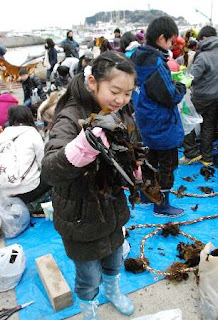Translated from the original article at:
http://machida.keizai.biz/headline/1060/
February 14, 2012
This photo (2010) is of Tamagawa College's "Future Sci Tech Lab" set-up. Plants such as lettuce and herbs are grown through the use of
LED technology. Plants are cultivated with the lowest possible cost light source, luminous LED panels. The combined use of LED panels,
hydroponic equipment and control systems are researched to discover how to obtain optimal results.
Responding to consumer's demands for peace of mind and safety from food, Tamagawa College and Nishimatsu Construction will begin growing lettuce in a plant factory from October of this year. The areas affected by the disaster of Eastern Japan are planning to adopt the system of this new farming business model and use it in their economic revitalization, with farming being central to the area's recover plans. This system is also being proposed and implemented outside of Japan.
On January 17th, both companies concluded a contract to be used as the basis for their dealings with each other. Currently under construction is the TAMAGAWA-NISHIMATSU Produce-Plant Factory, a 2 story building covering 900 square meters (9688 square feet). Set up in the facility are such facilities as a clerical office, administrative office and practice/training room, with power being supplied by solar energy panels.
Professor Watanabe Hiroyuki of Tamagawa University's agricultural department began development of the factory in 2009. Applying for a patent in direct-cooling high powered LEDs, he hopes to adopt them for use in the hydroponic cultivation system. Compared to the methods of sunlight and fluorescent lamps, the lighting system is said to make available products of exceptional efficiency and quality.
By October, 600 hundred heads of lettuce will be grown per day. After 2 more years, additional production equipment will be added, which have the ability to grow produce besides lettuce and yield a scheduled total of 3900 crops per day. "Between high
value added produce from the energy conservation techniques, designs for efficiency in the manufacturing process and dividing the water, lighting and heating expenses by 2 to 3 times, we're hope to go towards conquering the issue of profitability," said Takayuki Endo, from the Real Estate Home Office of Nishimatsu Construction's New Project Promotion Section.
The manufactured produce will first be made available at Tamagawa Academy's student dining hall and is later planned to be sold at small stands in the surrounding area of the academy.
Original text:
玉川大学と西松建設が「植物工場」事業化へ-農業ビジネスモデルの構築目指す
(2012年02月14日)
玉川大学は2010年に「Future Sci Tech Lab」(写真)を建設。レタスやハーブなどのLED栽培技術の確立、植物栽培光源用の低コストな実用的高輝度LEDパネルの開発、LEDパネル光源・水耕栽培装置・栽培制御システムの組合せの最適化などの研究成果をあげた。
「食の安心・安全」に対する消費者ニーズに応えようと、玉川大学と西松建設は今年10月より、植物工場でリーフレタスの生産を始める。新たな農業ビジネスモデルを構築し、東日本大震災における被災地の産業復興策、農業を中心とした地域活性策として、広く国内外に提案・実現する。
両者が1月17日に締結した「産学連携に関する協定書」に基づく取り組み。建設中の植物工場「TAMAGAWA-NISHIMATSU Produce-Plant Factory-」は地上2階建てで、延べ床面積は約900平方メートル。事務所、管理室、実習講習室などで使う電力を賄う太陽光発電システムを備える。
工場では、玉川大学農学部の渡邊博之教授が2009年に開発し、特許出願中の「ダイレクト冷却式ハイパワーLED」を使用する植物水耕栽培システムを採用。太陽光や白色蛍光灯で栽培した場合と比べて、格段に生産効率や生産物の品質を向上させることができるという。
リーフレタス600株を日産するシステムを10月に稼働。2年後に生産設備を増設して、レタス以外の作物も生産可能な日産3900株システムを稼働させる予定。「高付加価値な作物を省エネで効率的かつ計画的に生産することで、生産コストの2~3割かかる用水光熱費など収益性における課題を克服していきたい」と西松建設開発・不動産本部新規事業推進部の遠藤隆之さん。
生産した作物は、玉川学園の学生食堂をはじめ、玉川学園周辺の地元小売店に販売する予定。







